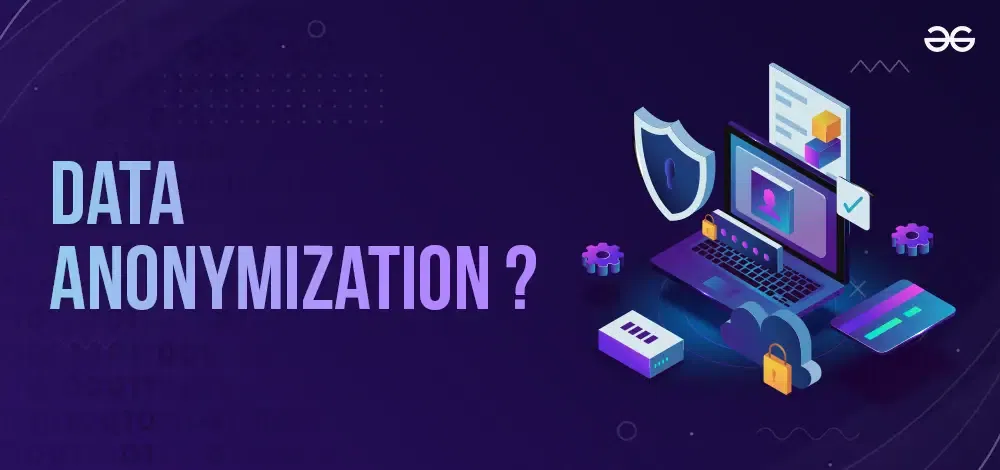What is Data Anonymization?
Last Updated :
25 Mar, 2024
With extensive data collection, protecting individual privacy while harnessing the power of data for analytics has become a paramount concern.
In this article we will explore the process of Data Anonymization, which serves as a vital solution to strike this delicate balance.

What is Data Anonymization?
Data anonymization is the process of modifying data to remove or obscure PII, making it impossible to identify individuals from the data set. This allows organizations to utilize valuable data for analytics, research, and other purposes while safeguarding individual privacy.
Data anonymization is particularly important in compliance with data protection regulations, such as GDPR, HIPAA, or CCPA, which mandate the responsible handling of personal information. By anonymizing data, organizations can share valuable insights without compromising individuals’ privacy rights, fostering trust and compliance. As businesses navigate the evolving landscape of data privacy, implementing robust data anonymization practices is essential for responsible and ethical data handling.
Techniques of Data Anonymization
Several techniques can be employed to anonymize data, each with its own advantages and limitations:
- Randomization: Randomization involves introducing random noise to data, preventing the identification of individuals while maintaining statistical properties. For example, perturbing numerical values or slightly modifying dates adds variability without compromising overall data patterns. This technique safeguards privacy by making it difficult to pinpoint specific individuals while preserving the integrity of the dataset for analysis.
- Generalization: Generalization involves summarizing or aggregating data at a higher level, reducing granularity to protect individual identities. This may include grouping specific attributes into broader categories, such as replacing precise ages with age ranges. By obscuring fine details, generalization ensures privacy while still allowing meaningful insights at a more abstract level.
- Suppression: Suppression entails removing certain data fields or entire records containing sensitive information. This technique is a straightforward approach to anonymization, eliminating the risk associated with specific attributes. While ensuring privacy, suppression may impact the analytical utility of the dataset, as certain details are intentionally omitted.
- Pseudonymization: Pseudonymization replaces direct identifiers, like names, with artificial identifiers or pseudonyms. This technique maintains the usability of the data while protecting individual identities. For instance, individuals’ names could be replaced with unique codes or aliases, allowing for analysis without direct identification.
- Tokenization: Tokenization involves replacing sensitive data with tokens or unique identifiers. This technique retains the overall structure of the dataset while replacing identifiable information. For instance, credit card numbers might be replaced with tokenized representations, allowing for secure analysis without exposing the original sensitive data.
- Data Swapping: Data swapping involves exchanging or swapping certain data between records to protect individual identities. By shuffling specific attributes or values between similar records, this technique adds an extra layer of privacy. For example, swapping demographic information or categorical variables among comparable records disrupts patterns that could lead to the re-identification of individuals.
- Data Perturbation: Data perturbation involves introducing deliberate changes or disturbances to the original data. By adding controlled noise or variability, this technique enhances privacy without sacrificing the overall utility of the dataset. For instance, perturbing numerical values or introducing slight modifications to categorical attributes helps obfuscate sensitive details, reducing the risk of re-identification while preserving the integrity of the data for analysis.
- Data Masking: Data masking involves concealing specific parts of data to prevent the exposure of sensitive information. This technique safeguards privacy by selectively hiding details while maintaining the overall structure of the dataset. For example, masking a portion of a credit card number, such as showing only the last four digits, ensures that critical details are obscured, minimizing the risk of unauthorized access or identification.
Key Benefits of Data Anonymization
- Enhanced privacy: Protects individuals from unauthorized identification and potential harm.
- Compliance with regulations: Ensures adherence to data privacy regulations like GDPR and CCPA.
- Facilitates data sharing: Enables safe sharing of data for research, collaboration, and innovation.
- Improved data security: Reduces the risk of data breaches and unauthorized access to sensitive information.
Which Data Should Be Anonymized?
Any data containing PII, such as:
- Names, addresses, and phone numbers
- Social security numbers, email addresses, and IP addresses
- Financial information, medical records, and biometric data
It’s crucial to identify and anonymize all sensitive data based on the specific context and regulations.
Disadvantages of Data Anonymization
While data anonymization is a crucial practice for safeguarding privacy, it is not without its drawbacks.
- Loss of Analytical Precision: Anonymization, often involving generalization or suppression, can result in a loss of fine-grained details, impacting the accuracy and granularity of analyses.
- Impact on Data Quality: Anonymization processes may introduce noise or distortion, affecting overall data quality.
- Limited Protection Against Insider Threats: Data anonymization focuses on external threats, providing limited safeguards against insider risks.
Conclusion
Data anonymization is a crucial tool for protecting privacy and ensuring the responsible use of data in today’s digital world. By removing or masking sensitive information, anonymization allows organizations to share and analyze data without compromising individuals’ privacy.
Share your thoughts in the comments
Please Login to comment...